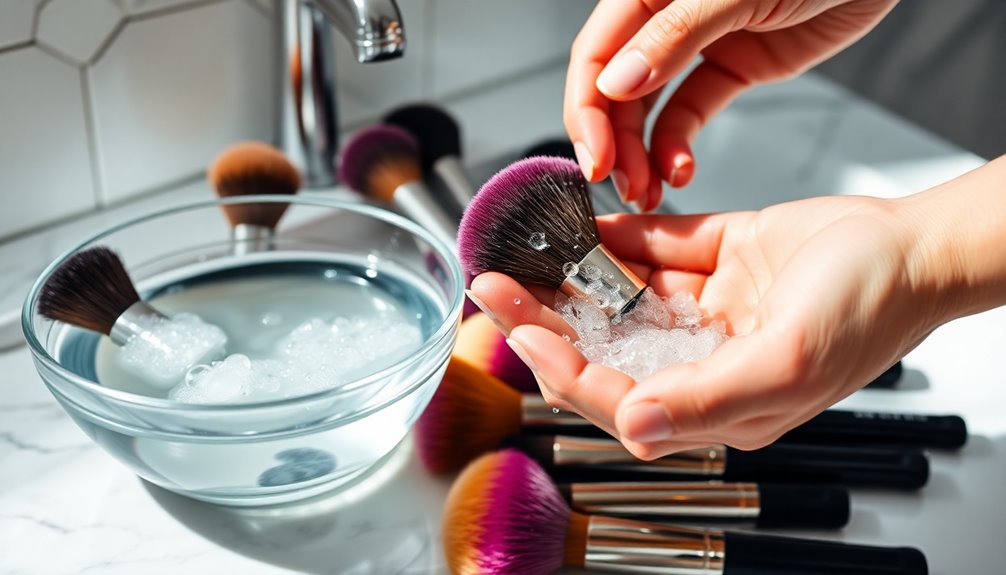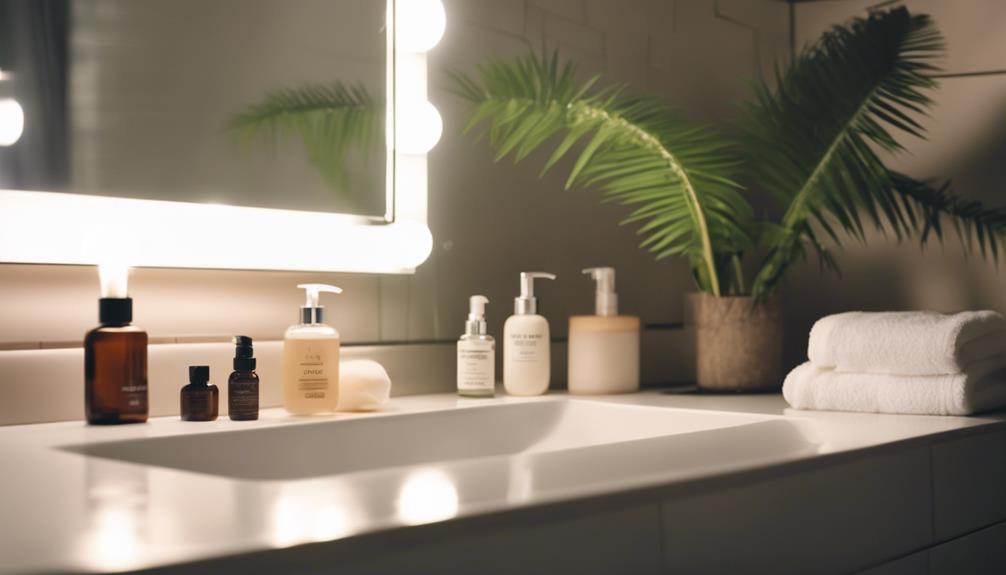Taking care of your makeup brushes is key to keeping them effective and your skin healthy. Clean your brushes regularly to prevent bacteria buildup, ideally every 1-2 weeks for powder brushes, and daily for liquid or cream brushes. Use gentle shampoos or specialized cleaners for the best results. After washing, rinse thoroughly and let them air dry upside down to maintain their shape. Store brushes upright in a cool, dry place to protect the bristles. By following these steps, you'll ensure your brushes perform at their best for flawless makeup application. There's more to discover about keeping your brushes in top shape!
Key Takeaways
- Clean powder brushes every 1-2 weeks, while liquid and cream brushes should be cleaned daily to prevent bacteria growth.
- Use gentle cleaning solutions like baby shampoo, white vinegar, or specialized brush cleaners for effective cleansing.
- Follow a step-by-step cleaning process: rinse, lather, rinse again, and repeat if necessary for caked makeup.
- Air dry brushes in a well-ventilated area to prevent bacterial growth and maintain their shape, avoiding direct sunlight.
- Regularly inspect brushes for wear and replace them when bristles break or they cause skin irritation to ensure optimal performance.
Importance of Regular Cleaning
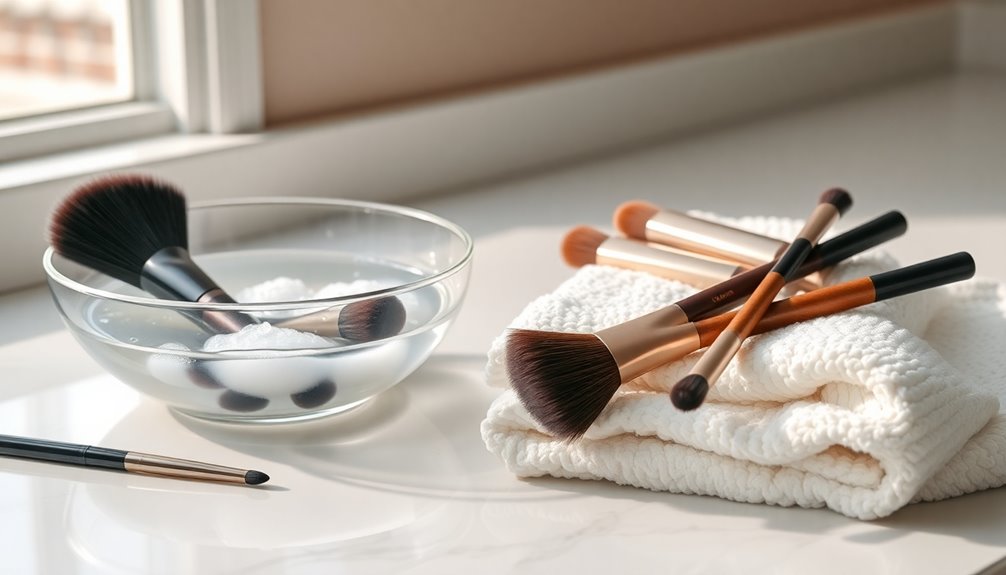
Regularly cleaning your makeup brushes is crucial for both your skin's health and your makeup application. When you skip this step, bacteria accumulate in the bristles, leading to skin irritation and acne. Even if you can't see them, invisible germ particles get trapped within, especially in wet conditions where liquid makeup products thrive.
By cleaning your brushes regularly, you eliminate these bacteria and significantly reduce the risk of skin infections, including eye infections. Additionally, clean brushes ensure a smoother, more flawless makeup application. Dirty brushes can create patchy or streaky results, ruining your desired look. With clean bristles, you achieve precise and accurate application, allowing for even product distribution.
Moreover, unclean brushes can clog your pores with built-up makeup, dead skin cells, and oil, leading to breakouts and irritations. By maintaining clean brushes, you help keep your skin healthy and radiant while preventing dullness caused by accumulated residue.
Lastly, regular cleaning extends the life of your brushes. Cleaned brushes maintain their shape and softness, preventing wear and tear, while also protecting the adhesive that holds the bristles. Prioritize this essential habit for both your skin and your makeup routine!
Frequency of Brush Cleaning
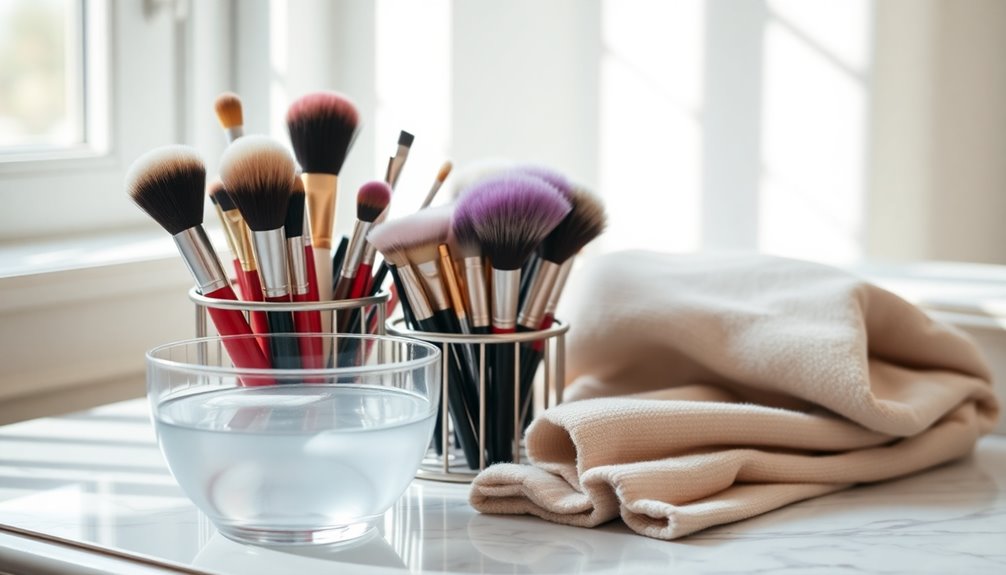
Cleaning your brushes is only part of the equation; knowing how often to do it's just as important. For brushes used with powders, aim to clean them every 1-2 weeks. If you have acne-prone or sensitive skin, weekly cleaning is essential to prevent buildup of powder residue and bacteria, which can lead to skin issues like acne and rashes. For those with normal skin, every two weeks is sufficient.
When it comes to brushes used for liquids or creams, you need to clean them daily. This is crucial for liquid foundations, concealers, and eyeshadows, as it prevents bacteria and mold growth, reducing the risk of serious infections. Consistent cleaning helps ensure that your brushes maintain their effectiveness over time.
Makeup sponges require even more attention; wash them after every use to avoid bacterial growth. Daily cleaning helps maintain your skin's health and extends the sponge's lifespan.
As a general guideline, clean your brushes every 7-10 days, but adjust based on your usage and skin type. Remember, sharing brushes can lead to infections, so keep your tools to yourself and prioritize proper cleaning and drying techniques for longevity.
Recommended Cleaning Solutions
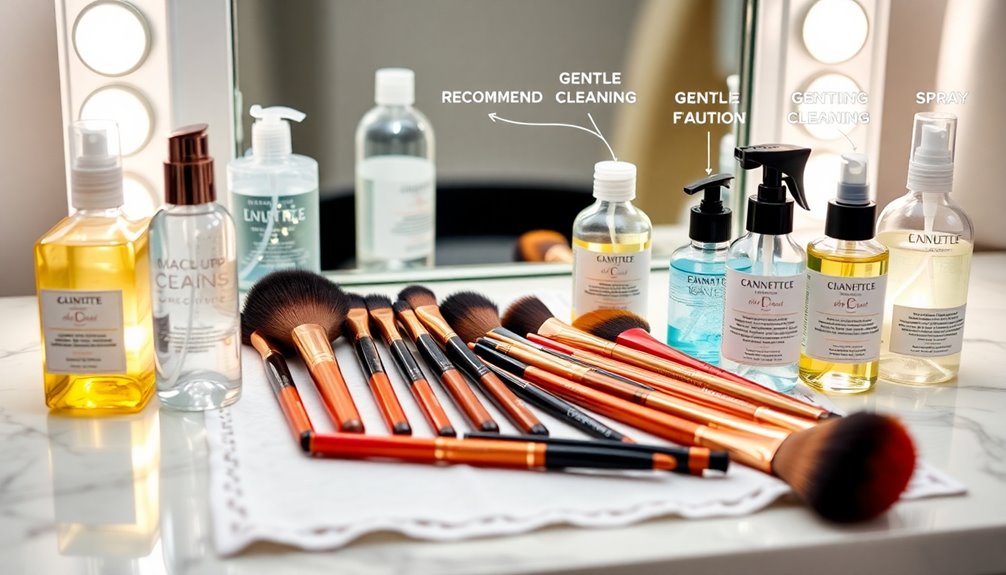
Finding the right cleaning solution for your makeup brushes can make a big difference in their performance and longevity. Start with gentle options like clarifying or baby shampoo, which effectively clean without drying out the bristles. Regular cleaning is essential for maintaining skin health and preventing breakouts.
Liquid dish soap can tackle caked-on makeup but use it sparingly to prevent damage. For a natural approach, try a mix of white vinegar and lemon—this not only disinfects but also leaves a fresh scent.
If you prefer specialized products, consider Beautyblender Solid Blendercleanser for portable cleaning or Cinema Secrets Makeup Brush Cleaner, which removes tough products without rinsing. You can also enhance your cleaning routine by adding a few drops of tea tree oil to your shampoo for its antiseptic benefits.
Don't forget to moisturize your brushes! Mixing olive oil or coconut oil with non-toxic dish soap works wonders for keeping bristles soft and supple.
Lastly, antibacterial soap can be a solid choice for thorough cleaning. By choosing the right cleaning solution, you'll extend the life of your brushes and ensure a flawless makeup application every time.
Essential Cleaning Tools
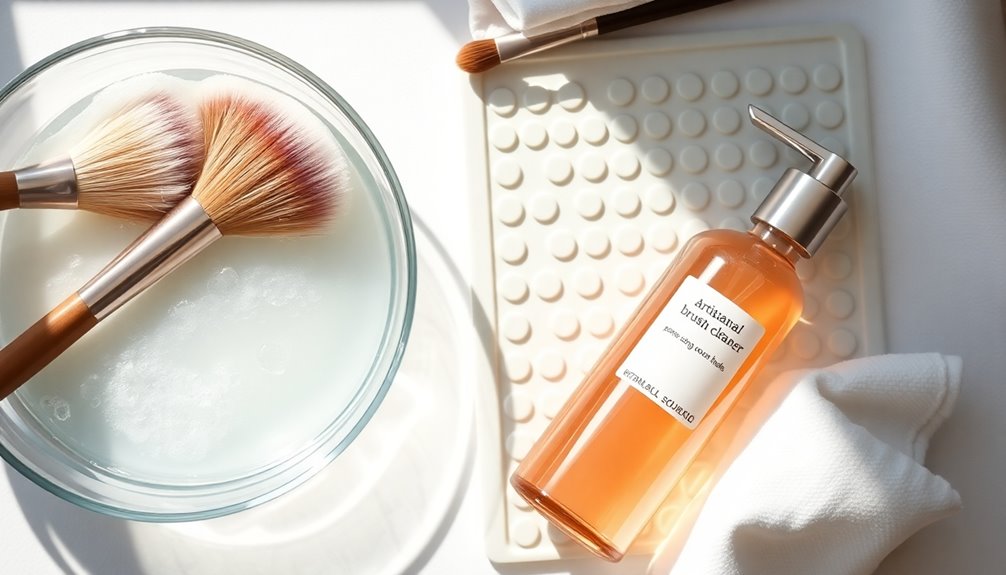
Maintaining your makeup brushes goes beyond just choosing the right cleaning solution; having the right tools at your disposal can make the process easier and more effective.
Start with a reliable brush cleaner like Cinema Secrets Makeup Brush Cleaner, which tackles waterproof and long-wear makeup. It comes in both spray and dipping formats, leaving your brushes smelling like vanilla and is available in multiple sizes to suit your needs.
For daily upkeep, consider EcoTools Daily Brush Cleaner. It's quick-drying, fragrance-free, and safe for sensitive skin, making it perfect for everyday use.
When deeper cleaning is necessary, the beautyblender Blendercleanser Solid offers an effective solution for both brushes and sponges, available in various scents.
Don't forget accessories that simplify your routine. The ULTA Beauty Collection Brush Cleansing Mitt is easy to use and clean, while the Real Techniques Handheld Textured Makeup Brush Cleansing Palette provides a portable option for thorough cleaning.
Alternatively, the J.Cat Beauty Silicone Pad Brush Cleaner is efficient and user-friendly. Lastly, for a monthly deep clean, EcoTools Makeup Brush + Sponge Shampoo is highly rated and cruelty-free.
Equip yourself with these essential tools to keep your brushes in top shape!
Step-by-Step Cleaning Process
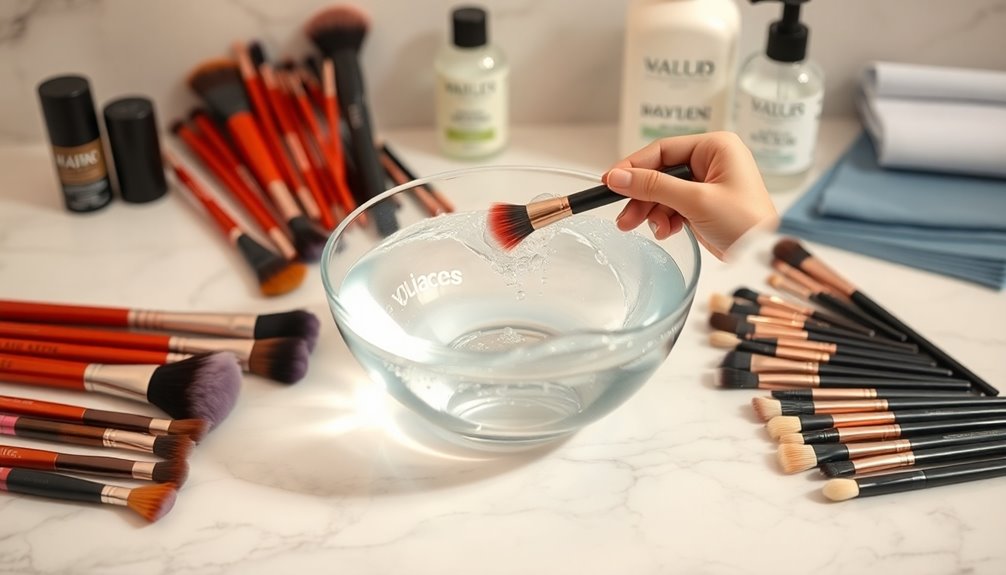
Starting the process of cleaning your makeup brushes can feel daunting, but breaking it down into manageable steps makes it much simpler.
Begin by rinsing the tips of your brushes under lukewarm running water. Focus only on the tips to avoid damaging the glue that holds the brush head and handle together. This initial rinse loosens any makeup residue effectively.
Next, fill a bowl with lukewarm water and add a tablespoon of gentle or clarifying shampoo—avoid plain soap as it can dry out the bristles. Swirl the brush tips in the shampoo mixture to create a lather, then massage them in your palm for extra cleaning power. Regular cleaning helps to protect skin from bacteria, ensuring that your brushes remain hygienic.
Afterward, rinse the brushes under running lukewarm water until the water runs clear, indicating that all makeup residue is gone.
Repeat the shampooing and rinsing process until thoroughly clean. If you encounter caked makeup, consider using liquid dish soap applied with a sponge.
Proper Drying Techniques
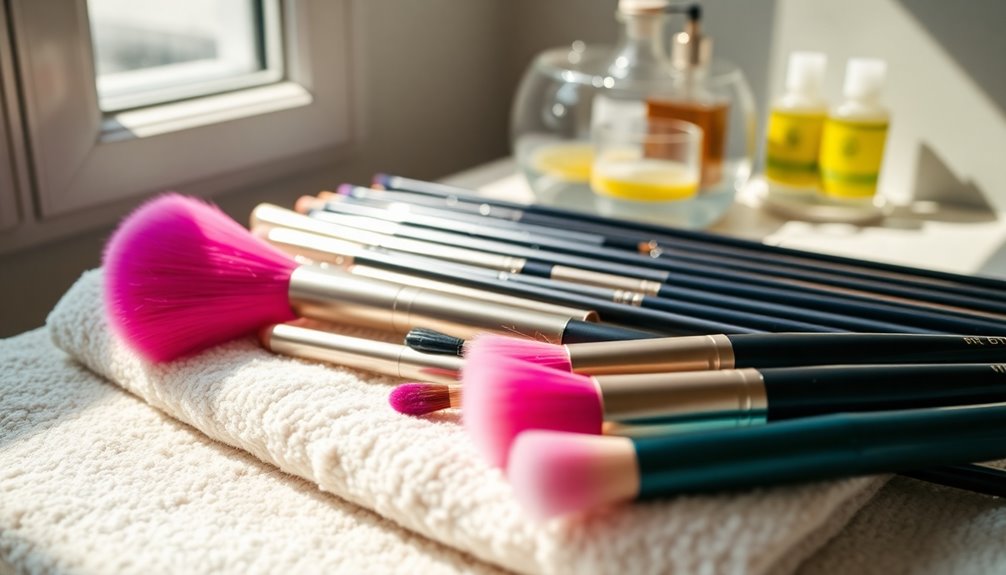
Proper drying techniques are essential for keeping your makeup brushes in top condition and extending their lifespan. After cleaning, gently squeeze out as much water as possible from the bristles. Next, use a dry towel to press out excess water and reshape the bristles to their original form.
Lay your brushes flat on a clean, dry towel, ensuring the bristles hang over the edge to allow for air circulation. This prevents water from seeping into the ferrule, which can loosen the glue and lead to bristle shedding. Regularly cleaning your brushes helps to maintain hygiene standards and ensures that they perform optimally.
Avoid drying your brushes standing up with the bristles facing upwards, as this can cause damage. If you want to maintain their shape, consider using a towel rack to dry them upside down. Make sure they're not squished or bent to avoid fraying.
Allow your brushes to air dry for several hours or overnight, keeping the drying area well-ventilated. You can also use a food dehydrator set to 100°F for a quicker drying option.
Storage Tips for Brushes
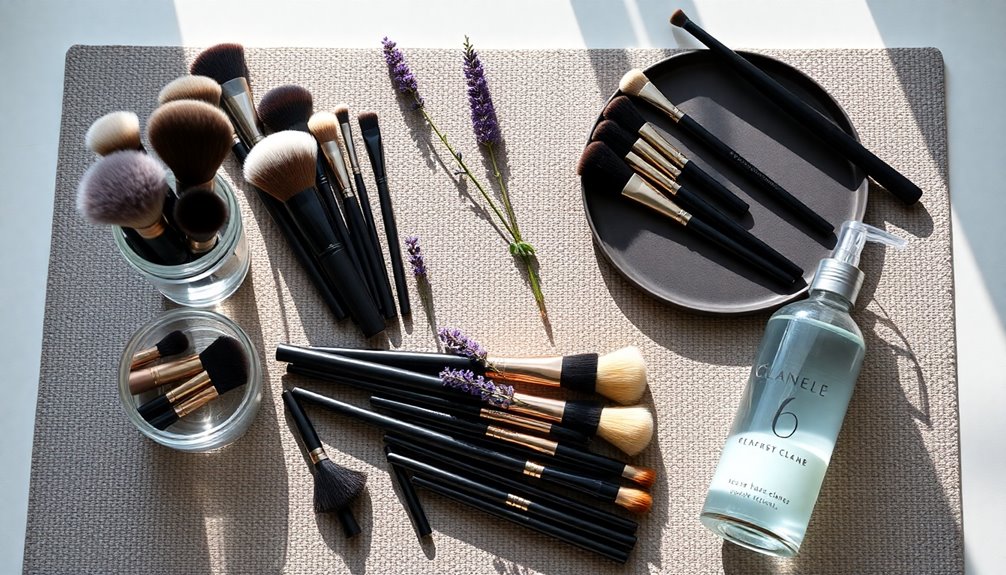
Taking care of your makeup brushes doesn't stop at cleaning; how you store them is just as crucial. Start by choosing a cool, dry location away from direct sunlight and humidity. Storing your brushes in a vanity drawer or on a dressing table away from windows is ideal. This helps maintain their quality and prevents issues like mold growth. Additionally, be mindful of environmental factors such as humidity and temperature, as they can significantly impact your brushes' longevity.
Next, opt for upright containers to keep your brushes in shape and protect the bristles. Zippered cases are great for keeping out dust, while brush rolls offer easy storage and travel options. You can also repurpose items like mason jars, crayon boxes, or even over-the-door shoe organizers for a creative twist.
Avoid common mistakes: don't store brushes with their bristles facing down, as this can lead to damage. Always ensure brushes are completely dry before storing to reduce the risk of bacterial growth.
Regularly check your stored brushes for any signs of damage or degradation. By following these storage tips, you’ll keep your brushes in top condition, ready for flawless makeup application every time. Additionally, it’s important to maintain a consistent balayage root touchup schedule to ensure your color remains fresh and vibrant. This will not only enhance your overall look but also help you avoid any drastic color shifts that can occur over time. By investing in both your brushes and your hair maintenance, you’ll achieve a polished appearance that elevates your beauty routine.
Brush Material Considerations
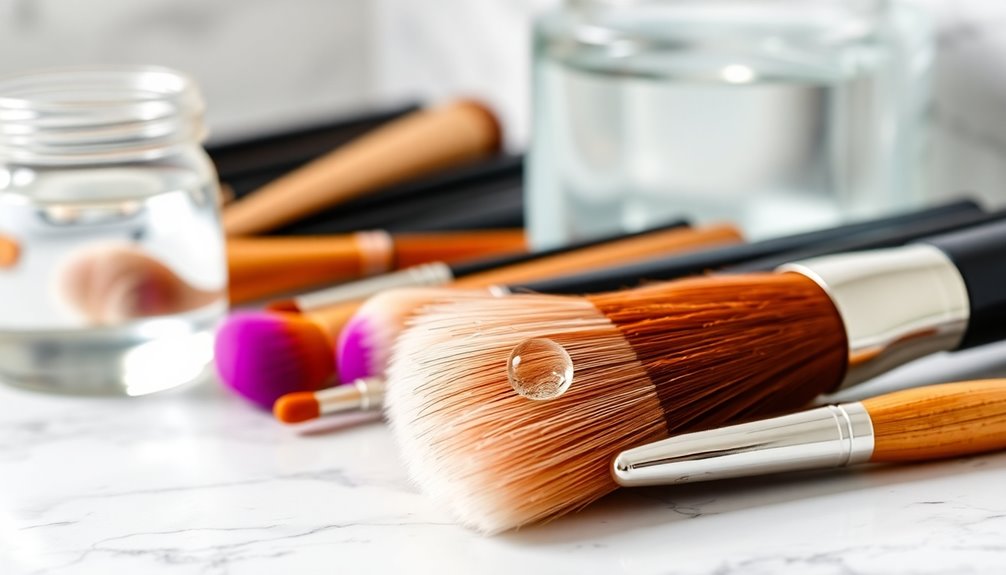
When choosing the right makeup brushes, it's essential to consider the materials used in their construction. You'll find two primary types: natural and synthetic.
Natural brushes are crafted from animal hair, like sable or goat, which gives them a soft feel and makes them excellent for blending powder products. Their cuticles help lift and absorb pigments, making them ideal for eyeshadow and powder blushes. However, they can trap bacteria and dead skin cells, leading to potential allergic reactions.
On the other hand, synthetic brushes, made from materials like nylon or polyester, are generally less soft but more affordable and accessible. Their bristles tend to cling together, allowing for precise application, especially with liquid and cream products like foundation and gel eyeliner. Additionally, synthetic brushes are less porous than natural hairs, which helps reduce makeup absorption and makes them easier to clean.
Ultimately, your choice should reflect your makeup preferences and sensitivity. Whether you opt for the luxurious feel of natural brushes or the practicality of synthetics, understanding these material differences will help you make informed decisions for your makeup routine.
Maintenance and Replacement Guidelines
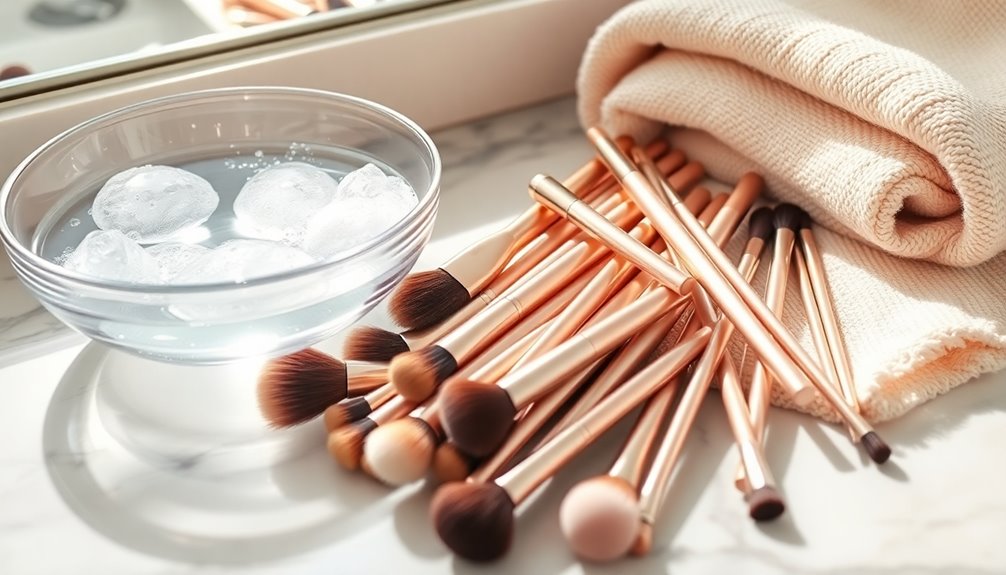
Maintaining your makeup brushes is crucial for both hygiene and performance, ensuring they last longer and work effectively. Clean your foundation and concealer brushes at least once a week to prevent product buildup and bacterial growth. If you use brushes frequently or work as a makeup artist, clean them after every use. Regular cleaning also helps to prolong brush lifespan and improves makeup application.
For eye shadow and liner brushes, a less frequent cleaning schedule is acceptable, but don't forget about them! Deep clean your brushes weekly to eliminate accumulated bacteria and oils.
When drying your brushes, hang them off the edge of a counter to maintain their shape and prevent mildew. Avoid laying them flat, as this can lead to mildew growth. Use a clean towel to squeeze out excess moisture gently, but don't rub the bristles.
Store your brushes in a clean, dry environment to avoid moisture accumulation.
Keep an eye on your brushes for signs of wear, like fiber breakage or bristle weakening. If they're no longer cleaning effectively or causing skin irritations, it's time for a replacement. Noticing changes in shape or performance? Don't hesitate to invest in new brushes!
Frequently Asked Questions
Can I Use Baby Shampoo to Clean My Makeup Brushes?
Yes, you can use baby shampoo to clean your makeup brushes. It's gentle yet effective at removing dirt and makeup. Just swirl the bristles in a small amount, rinse, and reshape for best results.
How Can I Tell if My Brushes Need Replacing?
You can tell your brushes need replacing if they shed bristles, apply makeup unevenly, or lose their shape. If they're difficult to clean or have unpleasant odors, it's time to invest in new ones.
Is It Safe to Use Alcohol for Cleaning Brushes?
It's not always safe to use alcohol for cleaning brushes. While it disinfects effectively, it can dry out natural fibers and damage brush hairs. Consider gentler alternatives for regular cleaning to maintain your brushes' longevity.
Do I Need to Clean My Brushes if I Don't Wear Makeup Daily?
Yes, you still need to clean your brushes, even if you don't wear makeup daily. Bacteria can accumulate, leading to skin issues. Regular cleaning keeps your brushes in good condition and protects your skin health.
Can I Share My Brushes With Others if They're Cleaned?
You shouldn't share your brushes, even if they're cleaned. Bacteria can easily transfer, leading to skin infections, breakouts, or eye issues. It's safer to use your own brushes to maintain healthy skin and hygiene.
Conclusion
In conclusion, taking care of your makeup brushes is essential for both your skin and makeup application. By regularly cleaning and maintaining them, you'll ensure they last longer and perform better. Remember to choose the right cleaning solutions and tools, and follow proper drying and storage techniques. With a little effort, you can keep your brushes in top shape and enjoy flawless makeup every time. So, make brush care a priority and watch your beauty routine improve!
